Посмотреть инструкция для GMC Terrain (2018) бесплатно. Руководство относится к категории автомобили, 4 человек(а) дали ему среднюю оценку 8.3. Руководство доступно на следующих языках: английский. У вас есть вопрос о GMC Terrain (2018) или вам нужна помощь? Задайте свой вопрос здесь
Не можете найти ответ на свой вопрос в руководстве? Вы можете найти ответ на свой вопрос ниже, в разделе часто задаваемых вопросов о GMC Terrain (2018).
Как перевести мили в километры?
Где я могу узнать идентификационный номер транспортного средства GMC?
Что такое идентификационный номер транспортного средства (VIN)?
Когда транспортному средству GMC требуется техническое обслуживание?
Когда следует заменять тормозную жидкость на GMC?
В чем разница между топливом E10 и E5?
Одна или несколько дверей не открываются изнутри. Что мне делать?
Автомобильный радиоприемник не включается, что делать?
Инструкция GMC Terrain (2018) доступно в русский?
Не нашли свой вопрос? Задайте свой вопрос здесь
GMC TERRAIN 2018: List of Available Documents
Note for Owners:
Guidesimo.com webproject is not a service center of GMC trademark and does not carries out works for diagnosis and repair of faulty GMC TERRAIN 2018 equipment. For quality services, please contact an official service center of GMC company. On our website you can read and download documentation for your GMC TERRAIN 2018 device for free and familiarize yourself with the technical specifications of device.
More Car Video System Devices:
-
Pyle PLMP4C4
DIGITAL VIDEO / MUSIC PLAYER MP3/WMA/AMV w/ FM Transmitter & 2” TFT Screen USER MANUAL _______________________________________________________________________ Before connecting, operating or adjusting this product please read these instructions completely. …
PLMP4C4 Car Video System, 8
-
Sony XAV-60 — 6.1 Inch Avc
CAMERA IN BUS AUDIO INBUS CONTROL INAUX AUDIO IN AUX VIDEO IN Source selector*Sélecteur de source*Selector de fuente*XA-C40*1 RCA pin cord (not supplied).*2 Do not remove the protective device.*3 Separate adaptor may be required.*4 Remove the cap from the USB connector before use.*5 Connect the yellow plug to AUX1 VIDEO IN.*6 For details on connecting to the parking brake switch cord, see “Conn …
XAV-60 — 6.1 Inch Avc Stereo Receiver, 2
-
Pioneer AVX-P8DVD
CAUTION:• PIONEER does not recommend that youinstall or service your display yourself.Installing or servicing the product mayexpose you to risk of electric shock orother hazards. Refer all installation andservicing of your display to authorizedPioneer service personnel.• Secure all wiring with cable clamps orelectrical tape. Do not allow any barewiring to remain exposed.• Do not drill a hole …
AVX-P8DVD Car Video System, 8
-
Toyota Prius 2011
T-SB-0309-10Rev2November5,20102011PriusPreDeliveryService(PDS)ServiceCategoryGeneralSectionPre-DeliveryServiceMarketUSAApplicabilityYEAR(S)MODEL(S)ADDITIONALINFORMATION2011PriusTSBREVISIONNOTICEJuly15,2011Rev2:•Step6hasbeenaddedtoUnderVehiclesection.Anypreviousprintedversionsofthisservicebulletinshouldbediscarded.December1,2010Rev1:•Precautionssectionhasbeenadded.Anypreviousprintedversionsofth …
Prius 2011 Automobile, 7
-
Sony XAV-701BT
CautionsRun all ground (earth) leads to a common ground (earth) point.This unit is designed for negative ground (earth) 12 V DC operation only.Do not disassemble or modify the unit.Do not install in locations which interfere with airbag operation.Do not get the leads under a screw, or caught in moving parts (e.g. seat railing).Before making connections, turn the …
XAV-701BT Other, 2
Recommended Documentation:
Ваш электронный адрес не будет опубликован. Обязательные поля помечены * *
КОММЕНТАРИЙ *
Имя и фамилия
Эл. адрес
Cайт
Сохраните мое имя, адрес электронной почты и веб-сайт в этом браузере для следующего комментария.
We have 47 GMC
Terrain manuals
covering a total of 9 years of production.
In the table below you can see 0
Terrain Workshop Manuals,0
Terrain Owners Manuals and 15 Miscellaneous
GMC Terrain downloads.
Our most popular manual is the
Gmc Terrain Awd Workshop Manual (L4-2.4L (2010))
.
This (like all of our manuals) is available to download for free in PDF format.
How to download a GMC Terrain
Repair Manual (for any year)
These Terrain manuals have been provided by our users,
so we can’t guarantee completeness. We’ve checked the years that the manuals cover
and we have GMC Terrain repair manuals
for the following years; 2010, 2011, 2012, 2013, 2014, 2015, 2016, 2017, 2018 and 2019.
Go through the 47 different PDF’s that are displayed below,
for example this one. You’ll then be shown the first 10 pages of this specific
document, you can then scroll down and click ‘show full PDF’. Then you can click
download you’ve got a totally free car manual, forever!
What topics does the GMC Terrain
Service/Repair Manual cover?
In total, that’s over 44752 pages of content dedicated to your
GMC Terrain. Here’s a non exhaustive list
of what’s covered;
- GMC Terrain service manual for roadside repairs
- GMC Terrain owners manual covering weekly checks
- GMC Terrain workshop manual covering Lubricants, fluids and tyre pressures
- GMC Terrain service PDF’s covering routine maintenance and servicing
- Detailed GMC Terrain Engine and Associated Service Systems (for Repairs and Overhaul) (PDF)
- GMC Terrain Transmission data Service Manual PDF
- GMC Terrain Brakes and suspension PDF
- GMC Terrain Wiring Diagrams
Looking for a Free GMC Terrain Haynes /
GMC Terrain Chilton Manuals?
We get a lot of people coming to the site looking to get themselves a free
GMC Terrain Haynes
manual. There are two things you need to know; firstly it’s illegal, and secondly —
there are much better ways of servicing and understanding your
GMC Terrain engine than
the Haynes manual. That’s essentially what we’re here for — to give you an
alternative to the Haynes and Chilton, online and totally for free.
Show more
Show less
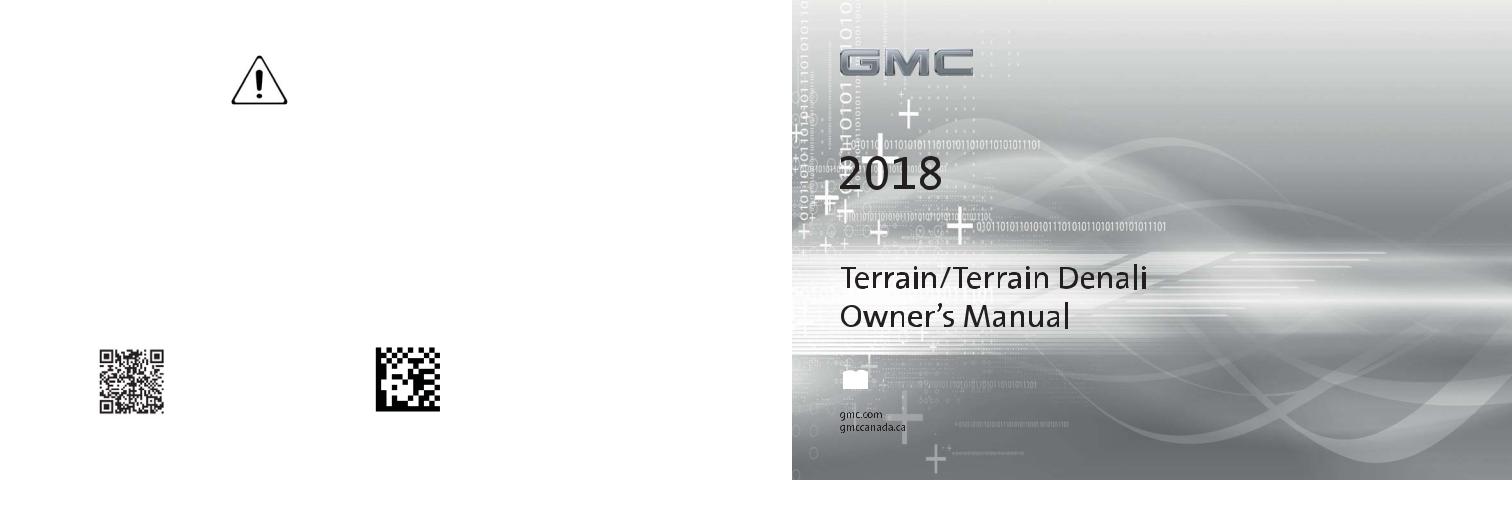

Contents
Introduction . . . . . . . . . . . . . . . . . . . . . . 2
In Brief . . . . . . . . . . . . . . . . . . . . . . . . . . . 5
Keys, Doors, and Windows . . . . . 28
Seats and Restraints . . . . . . . . . . . 54
Storage . . . . . . . . . . . . . . . . . . . . . . . 104
Instruments and Controls . . . . . . 108
Lighting . . . . . . . . . . . . . . . . . . . . . . . 149
Infotainment System . . . . . . . . . . 157
Climate Controls . . . . . . . . . . . . . . 158
Driving and Operating . . . . . . . . . 165
Vehicle Care . . . . . . . . . . . . . . . . . . 253
Service and Maintenance . . . . . 343
Technical Data . . . . . . . . . . . . . . . . 357
Customer Information . . . . . . . . . 361
Reporting Safety Defects . . . . . . 371
OnStar . . . . . . . . . . . . . . . . . . . . . . . . 375
Index . . . . . . . . . . . . . . . . . . . . 387

2Introduction
Introduction
The names, logos, emblems, slogans, vehicle model names, and vehicle body designs appearing in this manual including, but not limited to, GM, the GM logo, GMC, the GMC Truck Emblem, TERRAIN, and DENALI are trademarks and/or service marks of General Motors LLC, its subsidiaries, affiliates,
or licensors.
For vehicles first sold in Canada, substitute the name “General Motors of Canada Company” for GMC Motor Division wherever it appears in this manual.
Litho in U.S.A.
Part No. 23194369 A First Printing
This manual describes features that may or may not be on the vehicle because of optional equipment that was not purchased on the vehicle, model variants, country specifications, features/applications that may not be available in your region, or changes subsequent to the printing of this owner’s manual.
Refer to the purchase documentation relating to your specific vehicle to confirm the features.
Keep this manual in the vehicle for quick reference.
Canadian Vehicle Owners
A French language manual can be obtained from your dealer, at www.helminc.com, or from:
Propriétaires Canadiens
On peut obtenir un exemplaire de ce guide en français auprès du concessionnaire ou à l’adresse suivante:
Helm, Incorporated
Attention: Customer Service
47911 Halyard Drive
Plymouth, MI 48170
USA
Using this Manual
To quickly locate information about the vehicle, use the Index in the back of the manual. It is an alphabetical list of what is in the manual and the page number where it can be found.
About Driving the Vehicle
As with other vehicles of this type, failure to operate this vehicle correctly may result in loss of control or an accident. Be sure to read the driving guidelines in this manual in the section called “Driving and Operating” and specifically
Driver Behavior 0 166, Driving Environment 0 166, and Vehicle Design 0 166.
© 2017 General Motors LLC. All Rights Reserved.

Introduction 3
Danger, Warning, and
Caution
Warning messages found on vehicle labels and in this manual describe hazards and what to do to avoid or reduce them.
{Danger
Danger indicates a hazard with a high level of risk which will result in serious injury or death.
{Warning
Warning indicates a hazard that could result in injury or death.
Caution
Caution indicates a hazard that could result in property or vehicle damage.
A circle with a slash through it is a safety symbol which means “Do Not,” “Do not do this,” or “Do not let this happen.”
Symbols
The vehicle has components and labels that use symbols instead of text. Symbols are shown along with the text describing the operation or information relating to a specific component, control, message, gauge, or indicator.
M : Shown when the owner’s manual has additional instructions or information.
* : Shown when the service manual has additional instructions or information.
0 : Shown when there is more information on another page — “see page.”
Vehicle Symbol Chart
Here are some additional symbols that may be found on the vehicle and what they mean. See the features in this manual for information.
9 : Airbag Readiness Light
# : Air Conditioning
! : Antilock Brake System (ABS) $ : Brake System Warning Light
» : Charging System
I : Cruise Control
` : Do Not Puncture
^ : Do Not Service
B : Engine Coolant Temperature
O : Exterior Lamps
_ : Flame/Fire Prohibited
. : Fuel Gauge
+ : Fuses
3 : Headlamp High/Low-Beam Changer
j : LATCH System Child Restraints
* : Malfunction Indicator Lamp

4Introduction
: : Oil Pressure
O : Power
/ : Remote Vehicle Start
> : Seat Belt Reminders
7 : Tire Pressure Monitor
d : Traction Control/StabiliTrak
a : Under Pressure
M : Windshield Washer Fluid

In Brief
Instrument Panel
Instrument Panel . . . . . . . . . . . . . . . . 6
Initial Drive Information
Initial Drive Information . . . . . . . . . . 8
Stop/Start System . . . . . . . . . . . . . . . 8
Remote Keyless Entry (RKE)
System . . . . . . . . . . . . . . . . . . . . . . . . 8
Remote Vehicle Start . . . . . . . . . . . 8
Door Locks . . . . . . . . . . . . . . . . . . . . . 9
Liftgate . . . . . . . . . . . . . . . . . . . . . . . . . . 9
Windows . . . . . . . . . . . . . . . . . . . . . . . 10
Seat Adjustment . . . . . . . . . . . . . . . 11
Memory Features . . . . . . . . . . . . . . 13
Heated and Ventilated Seats . . . 13
Head Restraint Adjustment . . . . 14
Seat Belts . . . . . . . . . . . . . . . . . . . . . 14
Passenger Sensing System . . . 14
Mirror Adjustment . . . . . . . . . . . . . . 15
Steering Wheel Adjustment . . . . 15
Interior Lighting . . . . . . . . . . . . . . . . 16
Exterior Lighting . . . . . . . . . . . . . . . 17
Windshield Wiper/Washer . . . . . . 17
Climate Controls . . . . . . . . . . . . . . . 18
Transmission . . . . . . . . . . . . . . . . . . 19
Vehicle Features
Infotainment System . . . . . . . . . . . 20
Steering Wheel Controls . . . . . . . 20
Cruise Control . . . . . . . . . . . . . . . . . 20
Driver Information
Center (DIC) . . . . . . . . . . . . . . . . . 20
Forward Collision Alert (FCA)
System . . . . . . . . . . . . . . . . . . . . . . . 21
Forward Automatic
Braking (FAB) . . . . . . . . . . . . . . . . 21
Lane Keep Assist (LKA) . . . . . . . 21
Lane Change Alert (LCA) . . . . . . 21
Surround Vision . . . . . . . . . . . . . . . 22
Rear Vision Camera (RVC) . . . . 22
Rear Cross Traffic Alert (RCTA)
System . . . . . . . . . . . . . . . . . . . . . . . 22
Parking Assist . . . . . . . . . . . . . . . . . 22
Automatic Parking
Assist (APA) . . . . . . . . . . . . . . . . . . 22
Power Outlets . . . . . . . . . . . . . . . . . 22
Universal Remote System . . . . . 23
Sunroof . . . . . . . . . . . . . . . . . . . . . . . . 23
Performance and Maintenance
Traction Control/Electronic Stability Control . . . . . . . . . . . . . . 24
Tire Pressure Monitor . . . . . . . . . . 24 Fuel (LYX — 1.5L L4 Turbo
Engine) . . . . . . . . . . . . . . . . . . . . . . . 25 Fuel (LTG — 2.0L L4 Turbo
Engine) . . . . . . . . . . . . . . . . . . . . . . . 25 Fuel (Diesel) . . . . . . . . . . . . . . . . . . . 25 E85 or FlexFuel . . . . . . . . . . . . . . . . 25
Engine Oil Life System . . . . . . . . 25 Driving for Better Fuel
Economy . . . . . . . . . . . . . . . . . . . . . 26 Diesel Particulate Filter . . . . . . . . 26 Diesel Exhaust Fluid . . . . . . . . . . . 27 Roadside Assistance
Program . . . . . . . . . . . . . . . . . . . . . . 27
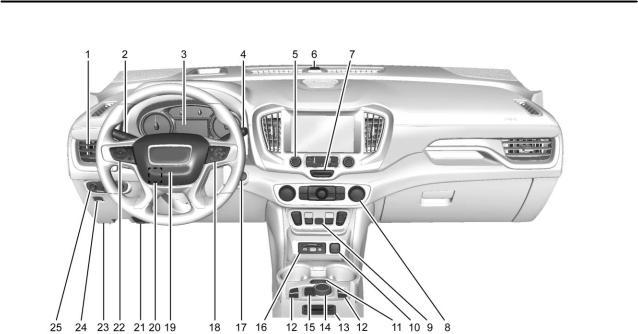
6In Brief
Instrument Panel

1.Air Vents 0 163.
2.Turn Signal Lever. See Turn and Lane-Change Signals 0 152.
IntelliBeam System Button (If Equipped). See Exterior Lamp Controls 0 149.
3.Instrument Cluster 0 117.
Driver Information Center (DIC) Display. See Driver Information Center (DIC) 0 134.
4.Windshield Wiper/Washer 0 109.
5.Infotainment 0 157.
6.Light Sensor. See Automatic Headlamp System 0 151.
7.Hazard Warning Flashers 0 152.
8.Climate Control Systems 0 158
(If Equipped).
Dual Automatic Climate Control System 0 160 (If Equipped).
9.Front Shift Console. See
Automatic Transmission 0 199.
10. Power Outlets 0 112.
11.Assistance Systems for Parking or Backing 0 218
(If Equipped).
12.Heated and Ventilated Front Seats 0 62 (If Equipped).
13.Wireless Charging 0 113
(If Equipped).
14.Driver Mode Control 0 212
(If Equipped).
15.Lane Keep Assist (LKA) 0 229
(If Equipped).
Hill Descent Control (HDC)
0 211 (If Equipped).
16.USB Port. See the infotainment manual.
Auxiliary Jack. See the infotainment manual.
17.ENGINE START/STOP Button. See Ignition Positions 0 182.
18.Steering Wheel Controls. See the infotainment manual.
19.Horn 0 109.
20.Steering Wheel Adjustment
0 109 (Out of View).
21.Hood Release. See Hood
0 256.
22.Cruise Control 0 215.
Heated Steering Wheel 0 109
(If Equipped).
Forward Collision Alert (FCA) System 0 223 (If Equipped).
23.Data Link Connector (DLC) (Out of View). See Malfunction Indicator Lamp (Check Engine Light) 0 125.
24.Electric Parking Brake 0 206.
25.Exterior Lamp Controls 0 149.
Instrument Panel Illumination Control 0 153.
Fog Lamps 0 153
(If Equipped).
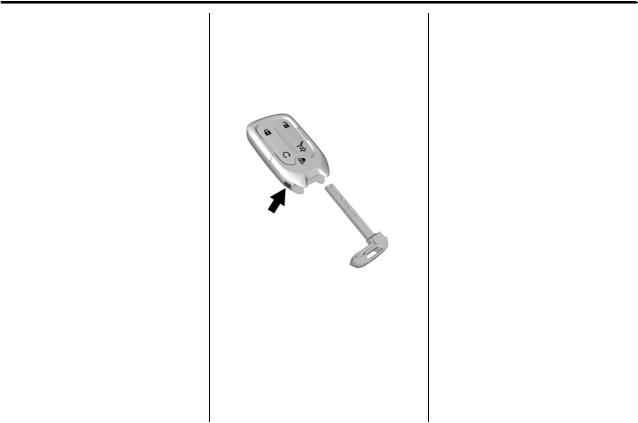
8In Brief
Initial Drive
Information
This section provides a brief overview about some of the important features that may or may not be on your specific vehicle.
For more detailed information, refer to each of the features which can be found later in this owner’s manual.
Stop/Start System
The vehicle may have a fuel saving STOP/START system to shut off the engine and help conserve fuel.
When the brakes are applied and the vehicle is at a complete stop, the engine may turn off. When the brake pedal is released or the accelerator pedal is pushed, the engine will restart. The engine may restart even while the brake is applied. See Starting the Engine
0 184.
Remote Keyless Entry
(RKE) System
The Remote Keyless Entry (RKE) transmitter may be used to lock and unlock the doors from up to 60 m (197 ft) away from the vehicle.
With Remote Start Shown
Press the key release button near the bottom of the transmitter to remove the key. The key can be used for the driver door.
Q : Press to lock all doors.
K : Press to unlock the driver door or all doors depending on the vehicle personalization settings.
Lock and unlock feedback can be personalized.
See Vehicle Personalization 0 140.
7 : Press and release one time to initiate vehicle locator.
Press and hold 7 for three seconds to sound the panic alarm. Press again to cancel the panic alarm.
b : Press twice quickly to open or close the liftgate. Press once to stop the liftgate from moving.
See Keys 0 28 and Remote Keyless Entry (RKE) System Operation 0 29.
Remote Vehicle Start
If equipped, the engine can be started from outside of the vehicle.
Starting the Vehicle
1.Press and release Q on the RKE transmitter.
2.Immediately press and hold / for at least four seconds or until the turn signal lamps flash.
When the vehicle starts, the parking lamps will turn on.

Remote start can be extended.
Start the vehicle normally after entering.
Canceling a Remote Start
To cancel a remote start, do one of the following:
.Press and hold / until the parking lamps turn off.
.Turn on the hazard warning flashers.
. Turn the vehicle on and then off.
See Remote Vehicle Start 0 35.
Door Locks
To lock or unlock the vehicle from the outside, press Q or K on the Remote Keyless Entry (RKE) transmitter.
Q : Press to lock the doors. The indicator light in the switch will illuminate when activated.
K : Press to unlock the doors.
See Door Locks 0 37.
To manually unlock a door from inside the vehicle, pull once on the door handle to unlock it, and a second time to open it.
Keyless Access
Press the button on the driver door when the RKE transmitter is within 1 m (3 ft). When unlocking from the driver door, the first press unlocks that door; press again within
five seconds to unlock all passenger doors. See Remote Keyless Entry (RKE) System Operation 0 29.
Liftgate
Manual Liftgate Operation
Unlock the vehicle before opening the liftgate.
To open the liftgate, press the touch pad on the bottom of the liftgate and lift up.
Do not press the touch pad while closing the liftgate. This may cause the liftgate to be unlatched.
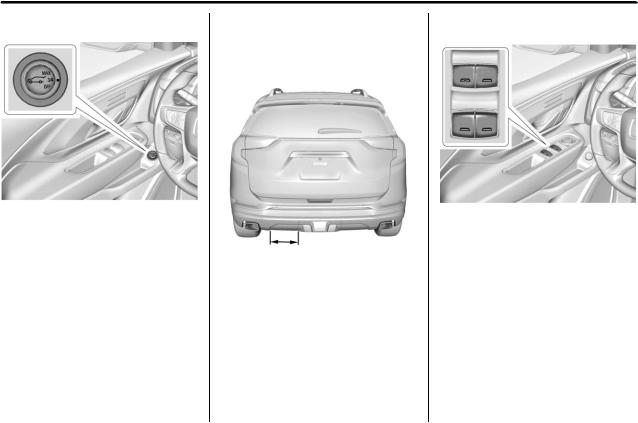
10 In Brief
Power Liftgate Operation
On vehicles with a power liftgate, the vehicle must be in P (Park) to use the power feature. The taillamps flash when the power liftgate moves.
Choose the power liftgate mode by turning the dial on the switch to either the 3/4 or MAX position.
Press 8to open or close the liftgate.
See Liftgate 0 41.
Hands-Free Liftgate
The liftgate will not operate if the RKE transmitter is not within
1 m (3 ft).
To operate, kick your foot straight up in one swift motion under the rear bumper between the left exhaust pipe and the license plate, then pull it back.
See Liftgate 0 41.
Windows
The power windows work when the ignition is on, in ACC/ACCESSORY, or when Retained Accessory Power (RAP) is active.
Using the window switch, press to open or pull to close the window.
The windows may be temporarily disabled if they are used repeatedly within a short time.
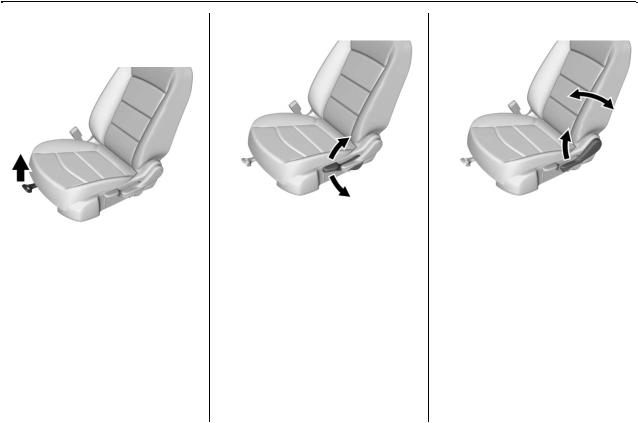
Seat Adjustment |
Seat Height Adjuster |
Reclining Seatbacks |
Manual Front Seats
To adjust a manual seat:
1.Pull the handle at the front of the seat.
2.Slide the seat to the desired position and release the handle.
3.Try to move the seat back and forth to be sure it is locked in place.
Move the lever up or down to manually raise or lower the seat.
See Seat Adjustment 0 57.
To recline the manual seatback:
1.Lift the lever.
2.Move the seatback to the desired position, then release the lever to lock the seatback in place.
3.Push and pull on the seatback to make sure it is locked.
To return the seatback to an upright position:
1.Lift the lever fully without applying pressure to the seatback, and the seatback returns to the upright position.
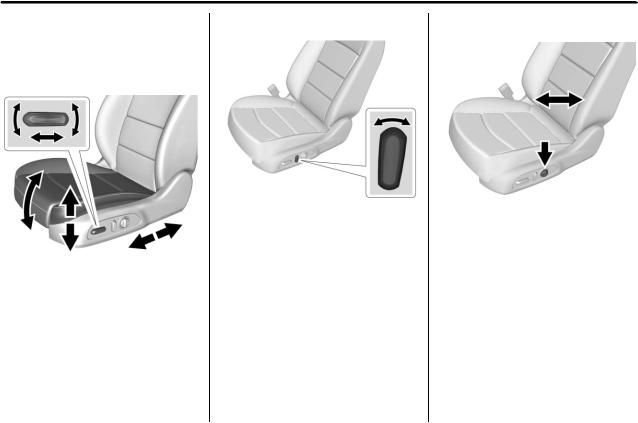
12 In Brief
2.Push and pull on the seatback to make sure it is locked.
See Reclining Seatbacks 0 58.
Power Driver Seat
To adjust a power driver seat, if equipped:
.Move the seat forward or rearward by sliding the control forward or rearward.
.Raise or lower the front part of the seat cushion by moving the front of the control up or down.
.Raise or lower the entire seat by moving the rear of the control up or down.
See Power Seat Adjustment 0 57.
To recline a power seatback, if equipped:
.Tilt the top of the control rearward to recline.
.Tilt the top of the control forward to raise.
See Reclining Seatbacks 0 58.
Lumbar Adjustment
If equipped, press and hold the front or rear of the control to increase or decrease lumbar support.
See Lumbar Adjustment 0 58.
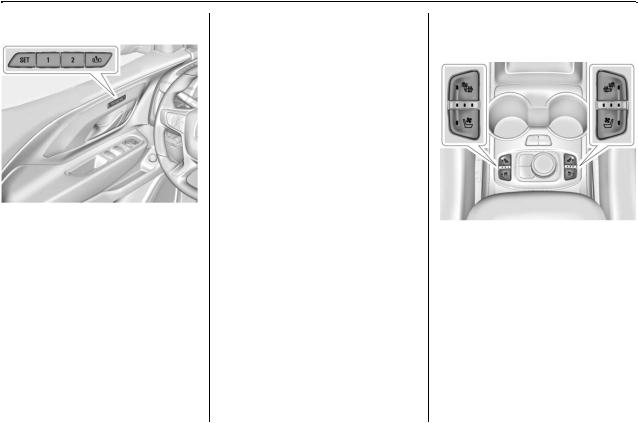
Memory Features
If equipped, memory seats allow two drivers to store and recall their unique seat positions for driving the vehicle, and a shared exit position for getting out of the vehicle. Other feature positions may also be set, such as power mirrors, if equipped. Memory positions are linked to RKE transmitter 1 or 2 for automatic memory recalls.
Before storing, adjust all available memory feature positions. Turn the ignition on and then press and release SET; a beep will sound. Then immediately press and hold 1,
2, or B (Exit) on the driver door until two beeps sound. To manually recall these positions, press and
hold 1, 2, or B until the saved position is reached.
When Auto Memory Recall is enabled in vehicle personalization, positions previously stored to memory buttons 1 and 2 are recalled when the ignition is changed from off to on or ACC/ ACCESSORY.
When Easy Exit Options is enabled in vehicle personalization, the feature automatically recalls the current driver’s previously stored exit position when exiting the vehicle. See Memory Seats 0 59.
Heated and Ventilated
Seats
If equipped, the buttons are on the center console. To operate, the engine must be running.
Press I or +, if equipped, to heat the driver or passenger
seatback only.
Press J or z to heat the driver or passenger cushion and seatback.
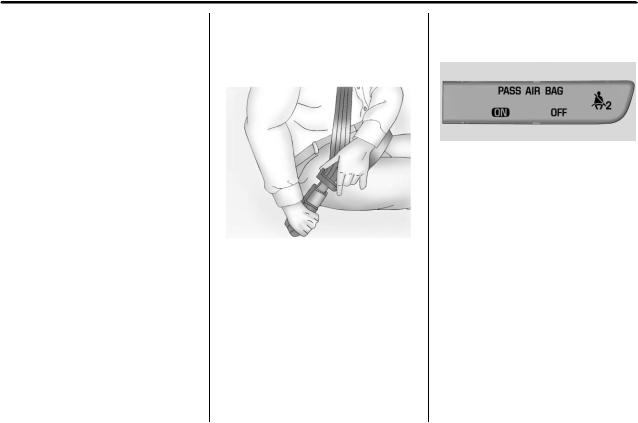
14 In Brief
Press Cor {, if equipped, to ventilate the driver or passenger seat. A ventilated seat has a fan that pulls or pushes air through the seat. The air is not cooled.
Press the heated or ventilated button once for the highest setting. With each press of the button, the heated or ventilated seat will change to the next lower setting, and then to the off setting. The lights indicate three for the highest setting and one for the lowest.
See Heated and Ventilated Front
Seats 0 62.
Head Restraint
Adjustment
Do not drive until the head restraints for all occupants are installed and adjusted properly.
To achieve a comfortable seating position, change the seatback recline angle as little as necessary while keeping the seat and the head restraint height in the proper position.
|
See Head Restraints 0 55 and Seat |
Passenger Sensing |
|
Adjustment 0 57. |
System |
Seat Belts |
Refer to the following sections for important information on how to use seat belts properly:
.Seat Belts 0 67.
.How to Wear Seat Belts Properly 0 68.
.Lap-Shoulder Belt 0 69.
.Lower Anchors and Tethers for Children (LATCH System) 0 93.
The passenger sensing system turns off the front outboard passenger frontal airbag under certain conditions. No other airbag is affected by the passenger sensing system. See Passenger Sensing System 0 80.
The passenger airbag status indicator will light on the overhead console when the vehicle is started. See Passenger Airbag Status Indicator 0 124.

Mirror Adjustment
Exterior
To adjust the mirrors:
1.Press j or | to choose the driver or passenger mirror.
2.Press the arrows on the control pad to move each mirror in the desired direction.
See Power Mirrors 0 49.
Interior
Adjustment
Adjust the rearview mirror to clearly view the area behind the vehicle.
Manual Rearview Mirror
For vehicles with a manual rearview mirror, push the tab forward for daytime use and pull it rearward for nighttime use to avoid the glare of the headlamps from behind. See
Manual Rearview Mirror 0 50.
Automatic Dimming Rearview
Mirror
Vehicles with an automatic dimming inside rearview mirror automatically reduce the glare of the headlamps from behind. The dimming feature comes on when the vehicle is started. See Automatic Dimming Rearview Mirror 0 50.
Steering Wheel
Adjustment
To adjust the steering wheel:
1.Pull the lever down.
2.Move the steering wheel up or down.
3.Pull or push the steering wheel closer or away from you.
4.Pull the lever up to lock the steering wheel in place.
Do not adjust the steering wheel while driving.
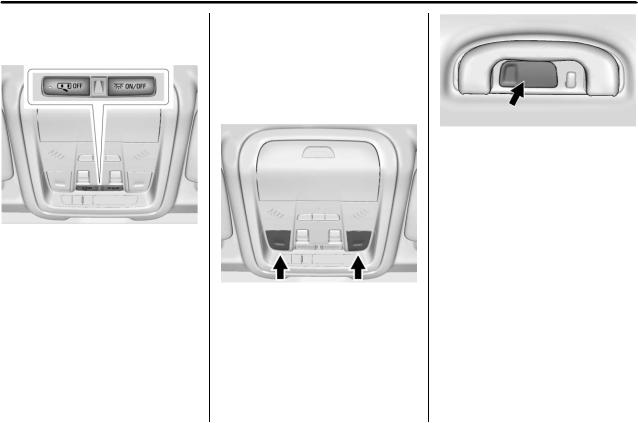
16 In Brief
Interior Lighting
Dome Lamps
The dome lamp controls are in the overhead console.
To operate, press the following buttons:
jOFF : Press to turn off the dome lamps when a door is open. An indicator light on the button will turn on when the dome lamp
override is activated. Press j OFF again to deactivate this feature and the indicator light will turn off. The dome lamps will come on when doors are opened.
+ ON/OFF : Press to turn the dome lamps on manually.
Reading Lamps
There are reading lamps on the overhead console and over the rear passenger doors. These lamps come on when any door is opened.
Front Reading Lamps
The front reading lamps are in the overhead console.
Press the lamp lenses to turn the front reading lamps on or off.
Rear Reading Lamps
Press the lamp lens to turn the rear passenger reading lamps on or off.
For more information on interior lighting, see Instrument Panel Illumination Control 0 153.
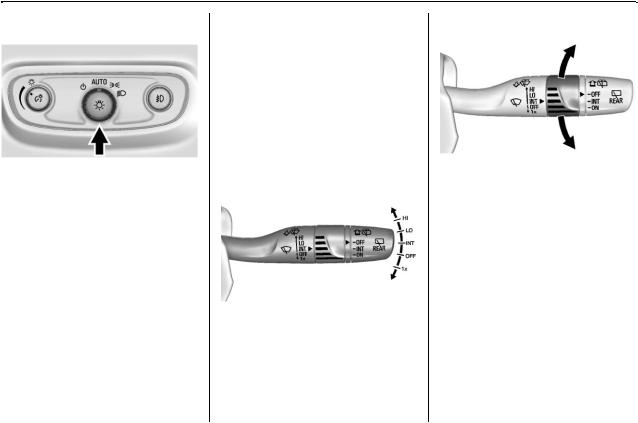
Exterior Lighting
The exterior lamp control is on the instrument panel to the left of the steering column.
There are four positions.
O : Turns the exterior lamps off and deactivates the AUTO mode. Turn
to O again to reactivate the AUTO mode.
In Canada, the headlamps will automatically reactivate when the vehicle is shifted out of P (Park).
AUTO : Turns the exterior lamps on and off automatically depending on outside lighting.
; : Turns on the parking lamps including all lamps, except the headlamps.
5 : Turns on the headlamps together with the parking lamps and instrument panel lights.
See:
.Exterior Lamp Controls 0 149
.Daytime Running Lamps (DRL) 0 151
.Fog Lamps 0 153
Windshield Wiper/Washer
The windshield wiper/washer lever is on the side of the steering column. With the ignition on or in ACC/ACCESSORY, move the windshield wiper lever to select the wiper speed.
HI : Use for fast wipes.
LO : Use for slow wipes.
INT : Move the lever up to INT for intermittent wipes, then turn the band up for more frequent wipes or down for less frequent wipes.
OFF : Use to turn the wipers off.
1X : For a single wipe, briefly move the wiper lever down. For several wipes, hold the wiper lever down.
f: Pull the windshield wiper lever toward you to spray windshield washer fluid and activate the wipers.
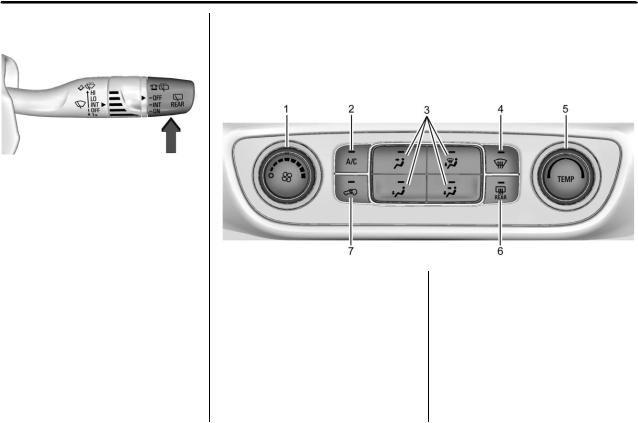
18 In Brief
Rear Window Wiper/Washer
Turn the end of the windshield wiper lever to operate the rear window wiper/washer.
OFF : Turns the system off.
INT : Intermittent wipes.
ON : Slow wipes.
1: Push the windshield wiper lever forward to spray washer fluid on the rear window. The lever automatically returns to its original position when released.
See Windshield Wiper/Washer
0 109 and Rear Window Wiper/
Washer 0 110.
Climate Controls
The vehicle’s heating, cooling, defrosting, and ventilation can be controlled with these systems.
Climate Control System
|
1. |
Fan Control |
5. |
TEMP (Temperature Control) |
|
2. |
A/C (Air Conditioning) |
6. |
Rear Window Defogger |
|
3. |
Air Delivery Mode Controls |
7. |
Air Recirculation |
|
4. |
Defrost |
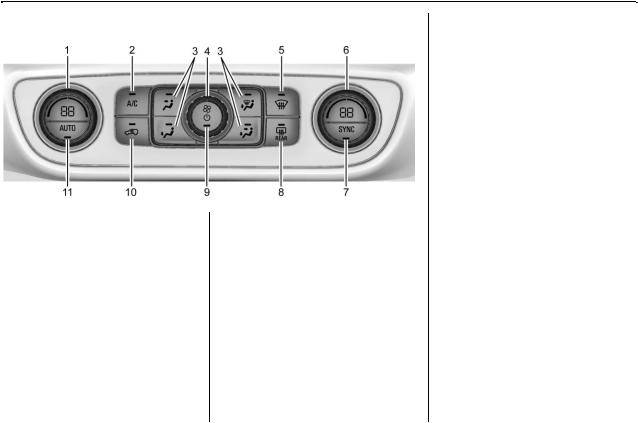
Dual Automatic Climate Control System
1.Driver Temperature Control
2.A/C (Air Conditioning)
3.Air Delivery Mode Controls
4.Fan Control
5.Defrost
6.Passenger Temperature Control
7.SYNC (Synchronized Temperature)
8.Rear Window Defogger
9.Power Button
10.Air Recirculation
11.AUTO (Automatic Operation)
See Climate Control Systems 0 158
(If Equipped) or Dual Automatic Climate Control System 0 160
(If Equipped).
Transmission
Electronic Range Select
(ERS) Mode
ERS or manual mode allows for the selection of the range of gear positions. Use this mode when driving downhill to limit the top gear and vehicle speed. See Manual Mode 0 204.
To use this feature:
1.Press the L (Low) button.
2.Press the plus/minus button on the front shift console to increase or decrease the gear range available.
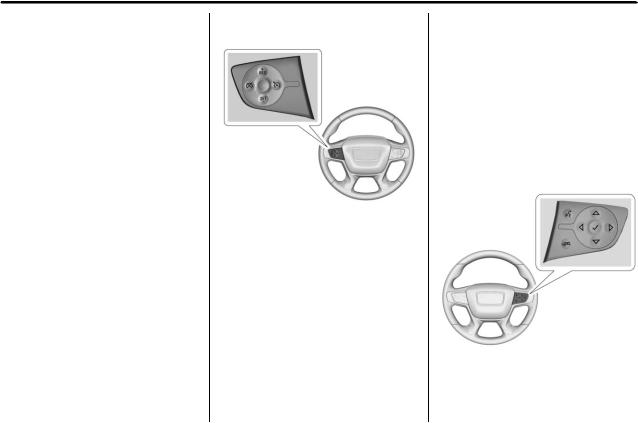
20 In Brief
Vehicle Features
Infotainment System
See the infotainment manual for information on the radio, audio players, phone, navigation system, and voice or speech recognition. It also includes information on settings.
Steering Wheel Controls
The infotainment system can be operated by using the steering wheel controls. See «Steering Wheel Controls» in the infotainment manual.
Cruise Control
J : Press to turn the cruise control system on and off. A white indicator comes on in the instrument cluster when cruise is turned on.
* : Press to disengage cruise control without erasing the set speed from memory.
+RES : If there is a set speed in memory, press to resume that speed or press and hold to accelerate. If cruise control is already active, use to increase vehicle speed.
−SET : Press briefly to set the speed and activate cruise control. If cruise control is already active, use to decrease vehicle speed.
See Cruise Control 0 215.
Driver Information
Center (DIC)
The DIC display is in the instrument cluster. It shows the status of many vehicle systems.
w or x : Press to move up or down in a list.

o or p : Press to move between the interactive display zones in the cluster.
V : Press to open a menu or select a menu item. Press and hold to reset values on certain screens.
See Driver Information Center (DIC) 0 134.
Forward Collision Alert
(FCA) System
If equipped, FCA may help avoid or reduce the harm caused by front-end crashes. FCA provides a
green indicator, V, when a vehicle is detected ahead. This indicator displays amber if you follow a vehicle too closely. When approaching a vehicle ahead too quickly, FCA provides a flashing red alert on the windshield and rapidly beeps or pulses the driver seat.
See Forward Collision Alert (FCA)
System 0 223.
Forward Automatic
Braking (FAB)
If the vehicle has Forward Collision Alert (FCA), it also has FAB, which includes Intelligent Brake
Assist (IBA). When the system detects a vehicle ahead in your path that is traveling in the same direction that you may be about to crash into, it can provide a boost to braking or automatically brake the vehicle. This can help avoid or lessen the severity of crashes when driving in a forward gear.
See Forward Automatic Braking (FAB) 0 225.
Lane Keep Assist (LKA)
If equipped, LKA may help avoid crashes due to unintentional lane departures. It may assist by gently turning the steering wheel if the vehicle approaches a detected lane marking without using a turn signal in that direction. It may also provide a Lane Departure Warning (LDW) alert as the lane marking is crossed. The system will not assist or alert if
it detects that you are actively steering. Override LKA by turning the steering wheel. LKA uses a camera to detect lane markings between 60 km/h (37 mph) and 180 km/h (112 mph).
See Lane Departure Warning (LDW) 0 229 and Lane Keep Assist (LKA) 0 229.
Lane Change Alert (LCA)
If equipped, the LCA system is a lane-changing aid that assists drivers with avoiding lane change crashes that occur with moving vehicles in the side blind zone (or spot) areas or with vehicles rapidly approaching these areas from behind. The LCA warning display will light up in the corresponding outside mirror and will flash if the turn signal is on. The Side Blind Zone Alert (SBZA) system is included as part of the LCA system.
See Side Blind Zone Alert (SBZA) 0 227 and Lane Change Alert (LCA) 0 227.

22 In Brief
Surround Vision
If equipped, views around the vehicle display in the infotainment display to aid with parking and low-speed maneuvers.
See “Surround Vision” under
Assistance Systems for Parking or Backing 0 218.
Front Vision Camera
If equipped, a view of the area in front of the vehicle displays on the infotainment display to aid with parking and low-speed maneuvers.
See “Front Vision Camera” under
Assistance Systems for Parking or Backing 0 218.
Rear Vision
Camera (RVC)
The RVC displays a view of the area behind the vehicle on the infotainment display when the vehicle is shifted into R (Reverse) to aid with parking and low-speed backing maneuvers.
See Assistance Systems for Parking or Backing 0 218.
Rear Cross Traffic Alert
(RCTA) System
If equipped, the RCTA system uses a triangle with an arrow on the infotainment display to warn of traffic behind your vehicle that may cross your vehicle’s path while in R (Reverse). In addition, beeps will sound, or the driver seat will pulse.
See Assistance Systems for Parking or Backing 0 218.
Parking Assist
If equipped, Rear Parking
Assist (RPA) uses sensors on the rear bumper to assist with parking and avoiding objects while in
R (Reverse). It operates at speeds less than 8 km/h (5 mph). RPA may show a warning triangle on the infotainment display and a graphic on the instrument cluster to provide the object distance. In addition, multiple beeps or seat pulses may occur if very close to an object.
The vehicle may also have the Front Parking Assist system.
See Assistance Systems for Parking or Backing 0 218.
Automatic Parking
Assist (APA)
If equipped, the APA system helps to search for and maneuver the vehicle into parallel or perpendicular parking spots using automatic steering, DIC displays, and beeps. When the vehicle speed is below
30 km/h (18 mph), press Oto enable the system.
See “Automatic Parking Assist (APA)” under Assistance Systems for Parking or Backing 0 218.
Power Outlets
The vehicle has two 12-volt accessory power outlets, which can be used to plug in electrical equipment, such as a cell phone or MP3 player.
There are power outlets:
.On the center stack below the climate control system.
.In the rear cargo area.
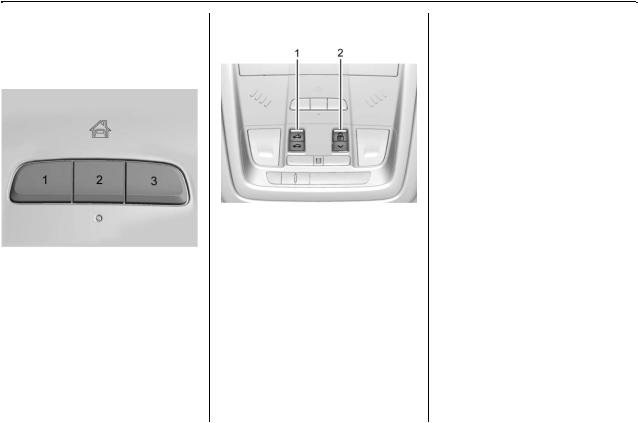
To use the outlet, remove the cover.
See Power Outlets 0 112.
Universal Remote System
If equipped, the Universal Remote System allows for garage door openers, security systems, and home automation devices to be programmed to work with these buttons in the vehicle.
See Universal Remote System 0 145.
Sunroof
1.Sunroof Switch
2.Sunshade Switch
If equipped, the sunroof only operates when the ignition is on or in ACC/ACCESSORY, or when Retained Accessory Power (RAP) is active. See Retained Accessory Power (RAP) 0 188.
Sunroof Switch
Express-Open/Express-Close : To express-open the sunroof, fully
press and release e(1). Press the switch again to stop it. To
express-close the sunroof, fully press and release g(1). Press the switch again to stop it.
Open/Close (Manual Mode) : To open the sunroof, press and hold e(1) until the sunroof reaches the desired position. Press and hold g(1) to close it.
Comfort Stop : The sunroof has a comfort stop feature that stops the sunroof from opening fully. Press
and release the rear of gto open the sunroof to the comfort open position. Pressing the rear of g again will open the sunroof fully.
If the sunshade is not fully open when the comfort stop feature is pressed the second time, the sunshade will open fully.
Vent : From the closed position, press e(1) to vent the sunroof.
Sunshade Switch
Express-open/Express-close : To express-open the sunshade, fully
press and release r (2). To

24 In Brief
express-close the sunshade, fully press and release s (2) . Press the switch again to stop it.
Open/Close : To open the sunshade, press and hold r (2) until the sunshade reaches the desired position.
When the sunroof is opened, an air deflector will automatically raise. The air deflector will retract when the sunroof is closed.
Performance and
Maintenance
Traction Control/
Electronic Stability
Control
The Traction Control System (TCS) limits wheel slip. The system is on when the vehicle is started.
The StabiliTrak system assists with directional control of the vehicle in difficult driving conditions. The system is on when the vehicle is started.
TCS and StabiliTrak can be turned off or on using the Driver Information Center (DIC) controls. See Traction Control/Electronic Stability Control 0 208.
Tire Pressure Monitor
This vehicle may have a Tire Pressure Monitor System (TPMS).
The low tire pressure warning light alerts to a significant loss in pressure of one of the vehicle’s tires. If the warning light comes on, stop as soon as possible and inflate the tires to the recommended pressure shown on the Tire and Loading Information label. See
Vehicle Load Limits 0 177. The warning light will remain on until the tire pressure is corrected.
The low tire pressure warning light may come on in cool weather when the vehicle is first started, and then turn off as the vehicle is driven. This may be an early indicator that the tire pressures are getting low and the tires need to be inflated to the proper pressure.
The TPMS does not replace normal monthly tire maintenance. Maintain the correct tire pressures.
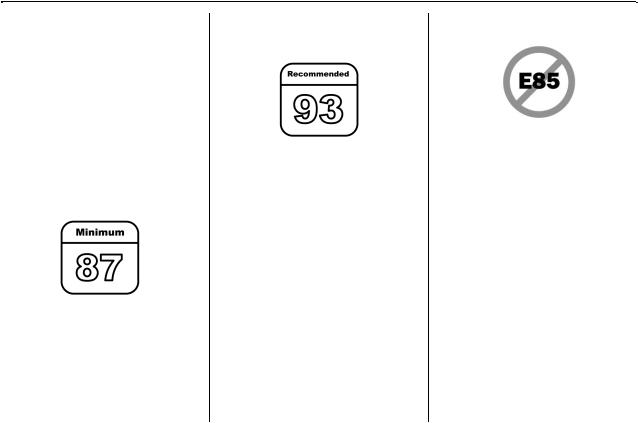
See Tire Pressure Monitor System 0 301.
Tire Fill Alert (If Equipped)
This feature provides visual and audible alerts outside the vehicle to help when inflating an underinflated tire to the recommended cold tire pressure. See “Tire Fill Alert (If Equipped)” under Tire Pressure Monitor Operation 0 302.
Fuel (LYX — 1.5L L4 Turbo
Engine)
Regular Fuel
Use only unleaded gasoline rated 87 octane or higher in your vehicle. Do not use gasoline with an octane rating lower as it may result in vehicle damage and lower fuel economy. See Fuel (Gasoline)
0 231.
|
Fuel (LTG — 2.0L L4 Turbo |
E85 or FlexFuel |
|
Engine) |
Premium Recommended Fuel
Use premium 93 octane unleaded gasoline in your vehicle. Unleaded gasoline with an octane rating as low as 87 may be used, but it will reduce performance and fuel economy. See Fuel (Gasoline)
0 231.
Fuel (Diesel)
Use of diesel fuel with ultra low sulfur content (15 ppm, maximum) is required. See Fuel for Diesel Engines 0 233.
No E85 or FlexFuel
Gasoline-ethanol fuel blends greater than E15 (15% ethanol by volume), such as E85, cannot be used in this vehicle.
Engine Oil Life System
The engine oil life system calculates engine oil life based on vehicle use and displays the CHANGE ENGINE OIL SOON message when it is time to change the engine oil and filter.
The oil life system should be reset to 100% only following an oil change.
Resetting the Oil Life System
1.Display REMAINING OIL LIFE on the DIC menu. See Driver Information Center (DIC) 0 134.

26 In Brief
2.Press and hold V for several seconds while the Oil Life display is active to reset the Oil Life system.
3.REMAINING OIL LIFE 100% will be displayed when the oil life system is successfully reset.
The oil life system can also be reset as follows:
1.Place the ignition in Service Mode. See Ignition Positions 0 182.
2.Display REMAINING OIL LIFE on the DIC menu. See Driver Information Center (DIC) 0 134.
3.Fully press and release the accelerator pedal three times within five seconds.
4.If the display changes to 100%, the system is reset.
See Engine Oil Life System 0 267.
Driving for Better Fuel Economy
Driving habits can affect fuel mileage. Here are some driving tips to get the best fuel economy possible.
.Avoid fast starts and accelerate smoothly.
.Brake gradually and avoid abrupt stops.
.Avoid idling the engine for long periods of time.
.When road and weather conditions are appropriate, use cruise control.
.Always follow posted speed limits or drive more slowly when conditions require.
.Keep vehicle tires properly inflated.
.Combine several trips into a single trip.
.Replace the vehicle’s tires with the same TPC Spec number molded into the tire’s sidewall near the size.
.Follow recommended scheduled maintenance.
Diesel Particulate Filter
The engine is equipped with a Diesel Particulate Filter (DPF) that will filter or trap particulates. The DPF is under the vehicle in the exhaust system.
Depending on a number of factors monitored by the engine computer, the DPF will need to be cleaned of accumulated solids. When a cleaning is needed, the engine computer will initiate a cleaning action by warming the exhaust gas temperature. This feature has been designed to operate automatically, with limited operator involvement or awareness.

Cleaning the DPF (Exhaust
Filter)
While the DPF cleaning is automatically controlled by the engine computer, the vehicle will need to operate continuously for approximately 25 minutes and at speeds greater than
50 km/h (30 mph) to clean the DPF effectively.
Special DPF Driver Messages
If the vehicle is used for numerous short trips or extended slow-speed operation, the engine computer may not be able to clean the DPF effectively. If this happens, a Driver Information Center (DIC) message will display.
If the vehicle continues to be driven in a manner that prevents effective DPF cleaning, the DPF will become plugged. If this occurs, the engine computer will turn on the malfunction indicator lamp in the instrument cluster and a DIC message will display.
See Diesel Particulate Filter 0 193, Fuel for Diesel Engines 0 233 and Engine Oil 0 263.
Diesel Exhaust Fluid
Diesel Exhaust Fluid (DEF) is used with diesel engines to reduce the amount of regulated emissions produced. The DEF system must be maintained for the vehicle to run properly. It is normal to hear the DEF system purge fluid back into the tank after the vehicle is shut off.
Locating Diesel Exhaust Fluid
DEF can be purchased at a GMC dealer. It can also be purchased at authorized vehicle dealerships.
Additionally, some diesel fueling stations or retailers may have DEF. For vehicles with an active OnStar subscription, OnStar can help to locate a DEF retailer. See Customer Assistance Offices 0 363 for phone numbers to assist you in contacting a GM dealer. See Recommended Fluids and Lubricants 0 353.
As the DEF tank becomes low on fluid, warnings begin with approximately 1 600 km (1,000 mi) of remaining range. These warnings will increase in intensity as the tank becomes empty. Once the tank is empty, the vehicle speed will be limited. If there is an issue with the quality of the fluid or the exhaust fluid system, warnings will be displayed in the Driver Information Center (DIC). See Diesel Exhaust Fluid 0 194.
Roadside Assistance
Program
U.S.: 1-888-881-3302
TTY Users (U.S. Only): 1-888-889-2438
Canada: 1-800-268-6800
New GMC owners are automatically enrolled in the Roadside Assistance Program.
See Roadside Assistance Program 0 365.

28 Keys, Doors, and Windows
Keys, Doors, and
Windows
Keys and Locks
Keys . . . . . . . . . . . . . . . . . . . . . . . . . . . 28
Remote Keyless Entry (RKE)
System . . . . . . . . . . . . . . . . . . . . . . . 29
Remote Keyless Entry (RKE)
System Operation . . . . . . . . . . . . 29
Remote Vehicle Start . . . . . . . . . . 35
Door Locks . . . . . . . . . . . . . . . . . . . . 37
Power Door Locks . . . . . . . . . . . . . 39
Delayed Locking . . . . . . . . . . . . . . . 39
Automatic Door Locks . . . . . . . . . 40
Lockout Protection . . . . . . . . . . . . . 40
Safety Locks . . . . . . . . . . . . . . . . . . . 40
Doors
Liftgate . . . . . . . . . . . . . . . . . . . . . . . . 41
Vehicle Security
Vehicle Security . . . . . . . . . . . . . . . . 46
Vehicle Alarm System . . . . . . . . . 46
Immobilizer . . . . . . . . . . . . . . . . . . . . 47
Immobilizer Operation . . . . . . . . . 47
Exterior Mirrors
Folding Mirrors . . . . . . . . . . . . . . . . . 49
Heated Mirrors . . . . . . . . . . . . . . . . . 49
Automatic Dimming Mirror . . . . . 49
Reverse Tilt Mirrors . . . . . . . . . . . . 49
Interior Mirrors
Interior Rearview Mirrors . . . . . . . 50
Manual Rearview Mirror . . . . . . . . 50
Automatic Dimming Rearview
Mirror . . . . . . . . . . . . . . . . . . . . . . . . . 50
Windows
Windows . . . . . . . . . . . . . . . . . . . . . . . 50
Power Windows . . . . . . . . . . . . . . . 50
Sun Visors . . . . . . . . . . . . . . . . . . . . . 52
Roof
Sunroof . . . . . . . . . . . . . . . . . . . . . . . . 52
Keys and Locks
Keys
{Warning
Leaving children in a vehicle with a Remote Keyless Entry (RKE) transmitter is dangerous and children or others could be seriously injured or killed. They could operate the power windows or other controls or make the vehicle move. The windows will function with the RKE transmitter in the vehicle, and children or others could be caught in the path of a closing window. Do not leave children in a vehicle with an RKE transmitter.
Convex Mirrors . . . . . . . . . . . . . . . . 48
Power Mirrors . . . . . . . . . . . . . . . . . . 49
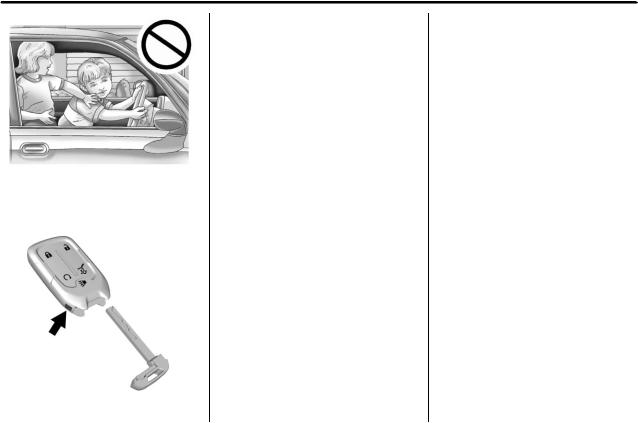
Keys, Doors, and Windows 29
The key, inside the Remote Keyless Entry (RKE) transmitter, is used for the driver door.
To remove the key, press the button near the bottom of the transmitter, and pull the key out. Never pull the key out without pressing the button.
If it becomes difficult to turn the key, inspect the key blade for debris.
See your dealer if a new key is needed.
Contact Roadside Assistance if locked out of the vehicle. See
Roadside Assistance Program 0 365.
With an active OnStar subscription, an OnStar Advisor may remotely unlock the vehicle. See OnStar Overview 0 375.
Remote Keyless Entry
(RKE) System
See Radio Frequency Statement 0 371.
If there is a decrease in the Remote Keyless Entry (RKE) operating range:
.Check the distance. The transmitter may be too far from the vehicle.
.Check the location. Other vehicles or objects may be blocking the signal.
.Check the transmitter’s battery. See “Battery Replacement” later in this section.
.If the transmitter is still not working correctly, see your dealer or a qualified technician for service.
Remote Keyless Entry
(RKE) System Operation
The Keyless Access system allows for vehicle entry when the transmitter is within 1 m (3 ft). See “Keyless Access Operation” following.
The RKE transmitter functions may work up to 60 m (197 ft) away from the vehicle.
Keep in mind that other conditions, such as those previously stated, can impact the performance of the transmitter.

30 Keys, Doors, and Windows
With Remote Start Shown, Without
Similar
Q : Press to lock all doors. The turn signal indicators may flash and/or the horn may sound on the second press to indicate locking. See
Vehicle Personalization 0 140.
If the driver door is open when Q is pressed, all doors will lock and then the driver door will immediately unlock, if enabled through vehicle personalization. If the passenger
door is open when Q is pressed, all doors lock.
Pressing Q may also arm the theft-deterrent system. See Vehicle Alarm System 0 46.
K : Press to unlock the driver door. Press unlock again within
five seconds to unlock all doors. The RKE transmitter can be programmed to unlock all doors on the first button press. See Vehicle Personalization 0 140. When remotely unlocking the vehicle at night the fog lamps and back-up lamps will come on for about
20 seconds to light your approach to the vehicle. The turn signal indicators may flash to indicate unlocking. See Vehicle Personalization 0 140.
Pressing K will disarm the theft-deterrent system. See Vehicle Alarm System 0 46.
On some models, pressing and holding K will open all of the windows, if enabled in vehicle personalization.
/ : If equipped, press and release Q and then immediately press and
hold / for at least four seconds to
start the engine from outside the vehicle using the RKE transmitter. See Remote Vehicle Start 0 35.
7 : Press and release one time to initiate vehicle locator. The exterior lamps flash and the horn chirps
three times. Press and hold 7 for three seconds to sound the panic alarm. The horn sounds and the turn signal lamps flash for
30 seconds, or until 7 is pressed again or the vehicle is started.
b : Press twice quickly to open or close the liftgate.
Press once to stop the liftgate from moving.
Keyless Access Operation
With the Keyless Access system, you can lock and unlock the doors and access the liftgate without removing the RKE transmitter from your pocket, purse, briefcase, etc. The RKE transmitter should be within 1 m (3 ft) of the liftgate or door being opened.

Keys, Doors, and Windows 31
Keyless Access can be programmed to unlock all doors on the first lock/unlock press from the driver door. See Vehicle Personalization 0 140.
If equipped with memory seats, RKE transmitters 1 and 2 are linked to the seating positions of memory 1 or 2. See Memory Seats 0 59.
Keyless Unlocking/Locking from the Driver Door
When the doors are locked and the RKE transmitter is within 1 m (3 ft) of the driver door handle, pressing the lock/unlock button on the driver door handle will unlock the driver door.
If the lock/unlock button is pressed again within five seconds, all passenger doors will unlock.
Driver Shown, Passenger Similar
Pressing the lock/unlock button will cause all doors to lock if any of the following occur:
.It has been more than
five seconds since the first lock/ unlock button press.
.Two lock/unlock button presses were used to unlock all doors.
.Any vehicle door has opened and all doors are now closed.
Keyless Unlocking/Locking from Passenger Doors
When the doors are locked and the RKE transmitter is within 1 m (3 ft) of the door handle, pressing the lock/ unlock button on that door handle will unlock all doors. Pressing the lock/unlock button will cause all doors to lock if any of the following occur:
.The lock/unlock button was used to unlock all doors.
.Any vehicle door has opened and all doors are now closed.
Passive Locking
If equipped with Keyless Access, this vehicle will lock several seconds after all doors are closed if the vehicle is off and at least one RKE transmitter has been removed or none remain in the interior.
If other electronic devices interfere with the RKE transmitter signal, the vehicle may not detect the RKE transmitter inside the vehicle.
If passive locking is enabled, the doors may lock with the RKE

32 Keys, Doors, and Windows
transmitter inside the vehicle. Do not leave the RKE transmitter in an unattended vehicle.
To customize the doors to automatically lock when exiting the vehicle, see “Remote Lock, Unlock, Start” under Vehicle Personalization 0 140.
Temporary Disable of Passive
Locking Feature
Temporarily disable passive locking by pressing and holding K on the interior door switch with a door open for at least four seconds, or until three chimes are heard. Passive locking will then remain disabled until Q on the interior door is pressed, or until the vehicle is turned on.
Remote Left in Vehicle Alert
When the vehicle is turned off and an RKE transmitter is left in the vehicle, the horn will chirp three times after all doors are closed. To turn on or off, see Vehicle Personalization 0 140.
Remote No Longer in Vehicle
If the vehicle is on, with a door open, and then all doors are closed, the vehicle will check for RKE transmitters inside. If an RKE transmitter is not detected, the Driver Information Center (DIC) will display NO REMOTE DETECTED and the horn will chirp three times. This occurs only once each time the vehicle is driven.
Keyless Liftgate Opening
Press the touch pad on the liftgate handle to open the liftgate if the RKE transmitter is within 1 m (3 ft).
Programming Transmitters to the Vehicle
Only RKE transmitters programmed to the vehicle will work. If a transmitter is lost or stolen, a replacement can be purchased and programmed through your dealer. The vehicle can be reprogrammed so that lost or stolen transmitters no longer work. Each vehicle can have up to eight transmitters matched
to it.
Programming with Recognized Transmitters
A new transmitter can be programmed to the vehicle when there are two recognized transmitters.
To program, the vehicle must be off and all of the transmitters, both currently recognized and new, must be with you.
1.Place the two recognized transmitters in the cupholder.
2.Remove the key lock cylinder cap on the driver door handle. See Door Locks 0 37. Insert the vehicle key of the new

Keys, Doors, and Windows 33
transmitter into the key lock cylinder on the driver door handle and turn the key, counterclockwise, to the unlock position five times within
10 seconds.
The Driver Information Center (DIC) displays READY FOR REMOTE #2, 3, 4, ETC.
3.Remove the two recognized transmitters from the cupholder.
4.Place the new transmitter into the cupholder.
5.Press ENGINE START/STOP. When the transmitter is learned the DIC display will show that it is ready to program the next transmitter.
6.Remove the transmitter from
the cupholder and press K or Q on the RKE transmitter.
To program additional transmitters, repeat Steps 4–6.
When all additional transmitters are programmed, press and hold ENGINE START/STOP for 12 seconds to exit programming mode.
7.Put the key back into the transmitter.
Programming without Recognized Transmitters
If two currently recognized transmitters are not available, follow this procedure to program up to eight transmitters. This feature is not available in Canada. This procedure will take approximately 30 minutes to complete. The vehicle must be off and all of the transmitters you wish to program must be with you.
1.Remove the key lock cylinder cap on the driver door handle. See Door Locks 0 37. Insert the vehicle key of the transmitter into the key lock cylinder on the driver door handle and turn the key, counterclockwise, to the unlock position five times within
10 seconds.
The Driver Information Center (DIC) displays REMOTE LEARN PENDING,
PLEASE WAIT.
2.Wait for 10 minutes until the DIC displays PRESS ENGINE START BUTTON TO LEARN and then press ENGINE START/STOP.
The DIC display will again show REMOTE LEARN PENDING, PLEASE WAIT.
3.Repeat Step 2 two additional times. After the third time all previously known transmitters will no longer work with the vehicle. Remaining transmitters can be relearned during the next steps.
The DIC display should now show READY FOR REMOTE
# 1.

34 Keys, Doors, and Windows
4.Place the new transmitter into the cupholder.
5.Press ENGINE START/STOP. When the transmitter is learned the DIC display will show that it is ready to program the next transmitter.
6.Remove the transmitter from
the cupholder and press K or Q on the RKE transmitter.
To program additional transmitters, repeat Steps 4–6.
When all additional transmitters are programmed, press and hold ENGINE START/STOP for 12 seconds to exit programming mode.
7.Put the key back into the transmitter.
Starting the Vehicle with a Low Transmitter Battery
When the vehicle is started, if the transmitter battery is weak, the DIC may display NO REMOTE DETECTED or NO REMOTE KEY WAS DETECTED PLACE KEY IN TRANSMITTER POCKET THEN START YOUR VEHICLE. The REPLACE BATTERY IN REMOTE KEY message may also be displayed at this time.
To start the vehicle:
1.Place the transmitter in the cupholder.
2.With the vehicle in P (Park) or N (Neutral), press the brake pedal and ENGINE START/STOP.
Replace the transmitter battery as soon as possible.
Battery Replacement
Replace the battery in the transmitter soon if the REPLACE BATTERY IN REMOTE KEY message displays in the DIC.

Keys, Doors, and Windows 35
Caution
When replacing the battery, do not touch any of the circuitry on the transmitter. Static from your body could damage the transmitter.
To replace the battery:
1.Press the button on the side of the transmitter to remove
the key.
2.Insert a flat, thin object in the center of the transmitter to separate and remove the back cover.
3.Lift the battery with a flat object.
4.Remove the battery.
5.Insert the new battery, positive side toward the back cover. Replace with a CR2032 or equivalent battery.
6.Push together the transmitter.
Remote Vehicle Start
The vehicle may have this feature that allows you to start the engine from outside the vehicle.
/ : This button will be on the RKE transmitter if the vehicle has remote start.
The climate control system will use the previous settings during a remote start. The rear defog may come on during remote start based on cold ambient conditions. The rear defog indicator light does not come on during remote start.
If the vehicle has heated and ventilated front seats, they may come on during a remote start. See
Heated and Ventilated Front Seats 0 62.
Laws in some local communities may restrict the use of remote starters. For example, some laws require a person using remote start to have the vehicle in view. Check local regulations for any requirements.

36 Keys, Doors, and Windows
Other conditions can affect the performance of the transmitter. See
Remote Keyless Entry (RKE) System 0 29.
Starting the Engine Using Remote
Start
1.Press and release Q on the RKE transmitter.
2.Immediately press and hold / for at least four seconds or until the turn signal lamps flash. The turn signal lamps flashing confirms the request to remote start the vehicle has been received.
The parking lamps will turn on and remain on as long as the engine is running. The vehicle’s doors will be locked.
3.Turn the ignition on before driving.
The engine will shut off after 10 minutes unless a time extension is done or the ignition is turned on.
Extending Engine Run Time
For a 10-minute extension, after 30 seconds repeat Steps 1 and 2
while the engine is still running. The remote start can be extended once.
When the remote start is extended, the second 10 minutes will be added.
For example, if the engine has been running for 10 minutes, and
10 minutes are added, the engine will run for a total of 20 minutes.
A maximum of two remote starts or a start with an extension are allowed between ignition cycles.
The vehicle must be started and then turned off before the remote start procedure can be used again.
Canceling a Remote Start
To shut off the engine:
.Press and hold / until the parking lamps turn off.
.Turn on the hazard warning flashers.
.Turn the ignition on and then off.
Conditions in Which Remote Start
Will Not Work
The remote vehicle start feature will not operate if:
.A transmitter is in the vehicle.
.The hood is not closed.
.The hazard warning flashers are on.
.There is an emission control system malfunction.
.The engine coolant temperature is too high.
.The oil pressure is low.
.Two remote vehicle starts or a start with an extension have already been used.
.The vehicle is not in P (Park).
Remote Start Ready
If the vehicle does not have the remote vehicle start feature, it may have the remote start ready feature. This feature allows your dealer to add the manufacturer’s remote vehicle start feature. See your

Keys, Doors, and Windows 37
dealer to add the manufacturer’s remote vehicle start feature to the vehicle.
Door Locks
{Warning
Unlocked doors can be dangerous.
.Passengers, especially children, can easily open the doors and fall out of a moving vehicle. The doors can be unlocked and opened while the vehicle is moving. The chance of being thrown out of the vehicle in a crash is increased if the doors are not locked. So, all passengers should wear seat belts properly and the doors should be locked whenever the vehicle is driven.
(Continued)
Warning (Continued)
.Young children who get into unlocked vehicles may be unable to get out. A child can be overcome by extreme heat and can suffer permanent injuries or even death from heat stroke. Always lock the vehicle whenever leaving it.
.Outsiders can easily enter through an unlocked door when you slow down or stop the vehicle. Locking the doors can help prevent this from happening.
To lock or unlock the door from outside the vehicle:
.Press Q or K on the Remote Keyless Entry (RKE) transmitter. See Remote Keyless Entry (RKE) System Operation 0 29.
.Use the key in the driver door. The key cylinder is covered with a cap.
To lock or unlock the door from inside the vehicle:
.Press Q or K on the power door lock switch.
.Push down on a door lock knob to lock a door.
.Pull the door handle once to unlock the door. Pull the handle again to unlatch it.
Keyless Access
If equipped, the RKE transmitter must be within 1 m (3 ft) of the liftgate or door being opened. Press the button on the door handle to

38 Keys, Doors, and Windows
open. See “Keyless Access Operation” in Remote Keyless Entry (RKE) System Operation 0 29.
Driver Door Key Lock Cylinder
Access (In Case of Dead
Battery)
To access the driver door key lock cylinder:
1.Pull the door handle (1) to the open position and hold it open until cap removal is complete.
2.Insert the key into the slot (3) on the bottom of the cap (2) and lift the key upward.
3.Move the cap (2) rearward and remove.
4.Use the key in the cylinder.
To replace the cap:
1.Pull the door handle (1) to the open position and hold it open until cap installation is complete.
2.Insert the two tabs (6) at the back of the cap between the seal (5) and the metal base (4).
3.Slide the cap forward and press the forward edge to install the cap in place.
4.Release the door handle.

Keys, Doors, and Windows 39
5. Check that the cap is secure.
Free-Turning Locks
The door key lock cylinder turns freely when either the wrong key is used, or the correct key is not fully inserted. The free-turning door lock feature prevents the lock from being forced open. To reset the lock, turn it to the vertical position with the correct key fully inserted. Remove the key and insert it again. If this does not reset the lock, turn the key halfway around in the cylinder and repeat the reset procedure.
Power Door Locks
Q : Press to lock the doors. The indicator light in the switch will illuminate when activated.
K : Press to unlock the doors.
Delayed Locking
This feature delays the actual locking of the doors until
five seconds after all doors are closed.
Delayed locking can only be turned on when the Open Door Anti-Lockout feature has been turned off.
When Q is pressed on the power door lock switch with the door open, a chime will sound three times indicating that delayed locking is active.
The doors will then lock automatically five seconds after all doors are closed. If a door is reopened before five seconds have elapsed, the five-second timer will reset once all the doors are closed again.
Press Q on the door lock switch
again, or press Q on the RKE transmitter, to override this feature and lock the doors immediately.
Delayed locking can be programmed. See Vehicle Personalization 0 140.

40 Keys, Doors, and Windows
Automatic Door Locks
The doors will lock automatically when all doors are closed, the ignition is on, and the vehicle is shifted out of P (Park) for automatic transmissions, or when the vehicle speed is above 13 km/h (8 mph) for manual transmissions.
If a vehicle door is unlocked and then opened and closed, the doors will lock either when your foot is removed from the brake or the vehicle speed becomes faster than 13 km/h (8 mph).
To unlock the doors:
.Press K on the power door lock switch.
.Shift into P (Park).
.If equipped with a manual transmission, turn the vehicle off when parked.
Automatic door locking cannot be disabled. Automatic door unlocking can be programmed. See Vehicle Personalization 0 140.
Lockout Protection
If the ignition is on or in ACC/ ACCESSORY and the power door lock switch is pressed with the driver door open, all the doors will lock and only the driver door will unlock.
If the vehicle is off and locking is requested while a door is open, when all doors are closed the vehicle will check for RKE transmitters inside. If an RKE transmitter is detected and the number of RKE transmitters inside has not reduced, the driver door will unlock and the horn will chirp three times.
Lockout Protection can be manually overridden by pressing and holding Q on the power door lock switch.
Open Door Anti-Lockout
If Open Door Anti-Lockout is turned on and the vehicle is off, the driver door is open, and locking is requested, all the doors will lock and only the driver door will unlock. The
Open Door Anti-Lockout feature can be turned on or off. See Vehicle Personalization 0 140.
Safety Locks
The rear door safety locks prevent passengers from opening the rear doors from inside the vehicle.
Manual Safety Locks
If equipped, the safety lock is on the inside edge of the rear doors. To use the safety lock:
1.Move the lever down to the lock position.
2.Close the door.

Keys, Doors, and Windows 41
3.Do the same for the other rear door.
To open a rear door when the safety lock is on:
1.Unlock the door by activating the inside handle, by pressing the power door lock switch, or by using the Remote Keyless Entry (RKE) transmitter.
2.Open the door from the outside.
When the safety lock is enabled, adults and older children will not be able to open the rear door from the inside. Cancel the safety locks to enable the doors to open from the inside.
To cancel the safety lock:
1.Unlock the door and open it from the outside.
2.Move the lever up to unlock. Do the same for the other door.
Doors
Liftgate
{Warning
Exhaust gases can enter the vehicle if it is driven with the liftgate or trunk/hatch open, or with any objects that pass through the seal between the body and the trunk/hatch or
liftgate. Engine exhaust contains carbon monoxide (CO) which cannot be seen or smelled. It can cause unconsciousness and even death.
If the vehicle must be driven with the liftgate or trunk/hatch open:
.Close all of the windows.
.Fully open the air outlets on or under the instrument panel.
.Adjust the climate control system to a setting that brings in only outside air
(Continued)
Warning (Continued)
and set the fan speed to the highest setting. See “Climate Control Systems” in the Index.
.If the vehicle is equipped with a power liftgate, disable the power liftgate function.
See Engine Exhaust 0 192.
Caution
To avoid damage to the liftgate or liftgate glass, make sure the area above and behind the liftgate is clear before opening it.
Manual Liftgate
To unlock the liftgate, press K on the power door lock switch or press K on the Remote Keyless Entry (RKE) transmitter twice within five seconds. See Remote Keyless
Entry (RKE) System Operation 0 29.

42 Keys, Doors, and Windows
To open the liftgate, press the touch pad on the bottom of the liftgate and lift up.
Use the pull cup to lower and close the liftgate. Do not press the touch pad while closing the liftgate. This may cause the liftgate to be unlatched.
Always close the liftgate before driving.
Power Liftgate Operation
{Warning
You or others could be injured if caught in the path of the power liftgate. Make sure there is no one in the way of the liftgate as it is opening and closing.
Caution
To avoid damage to the liftgate or liftgate glass, make sure the area above and behind the liftgate is clear before opening it.
If equipped with a power liftgate, the switch is usually on the driver door. The switch can also be on the overhead console. The vehicle must be in P (Park).
The modes are:
.MAX: Opens to maximum height.
.3/4: Opens to a reduced height that can be set from 3/4 to fully open. Use to prevent the liftgate from opening into overhead obstructions such as a garage door or roof-mounted cargo. The liftgate can be manually opened all the way.

Keys, Doors, and Windows 43
.OFF: Opens manually only.
To power open or close the liftgate, select MAX or 3/4 mode.
.Press b twice quickly on the RKE transmitter until the liftgate moves.
.Press 8on the driver door. The driver door must either be unlocked or locked without the security armed.
.Press the touch pad on the bottom of the liftgate after unlocking all doors. If equipped with Keyless Access, the RKE transmitter must be within
1 m (3 ft).
.Press l on the bottom of the liftgate next to the pull cup to close.
Press any liftgate button or the touch pad while the liftgate is moving to stop it. Pressing again restarts the operation in the reverse direction. The touch pad on the liftgate handle cannot be used to close the liftgate.
Caution
Manually forcing the liftgate to open or close during a power cycle can damage the vehicle. Allow the power cycle to complete.
The power liftgate may be temporarily disabled under extreme low temperatures, or after repeated power cycling over a short period of time. If this occurs, the liftgate can still be operated manually.
If the vehicle is shifted out of
P (Park) while the power function is in progress, the liftgate will continue to completion. If the vehicle is accelerated before the liftgate has completed moving, the liftgate may stop or reverse direction. Make sure the liftgate is closed and latched before driving.
Falling Liftgate Detection
If the power liftgate automatically closes after a power opening cycle, it indicates that the system is reacting to excess weight on the

44 Keys, Doors, and Windows
liftgate or a possible support strut failure. A repetitive chime will sound while the falling liftgate detection feature is operating. Remove any excess weight. If the liftgate continues to automatically close after opening, see your dealer for service before using the power liftgate.
Interfering with the power liftgate motion or manually closing the liftgate too quickly after power opening may resemble a support strut failure. This could also activate the falling liftgate detection feature. Allow the liftgate to complete its operation and wait a few seconds before manually closing the liftgate.
Obstacle Detection Features
If the liftgate encounters an obstacle during a power open or close cycle, the liftgate will automatically reverse direction and move a short distance away from the obstacle. After removing the obstruction, the power liftgate operation can be used again. If the liftgate encounters multiple obstacles on the same power cycle, the power function will deactivate.
After removing the obstructions, manually close the liftgate which will allow normal power operation functions to resume.
If the vehicle is locked while the liftgate is closing, and an obstacle is encountered that prevents the liftgate from completely closing, the horn will sound as an alert that the liftgate did not close.
Pinch sensors are on the side edges of the liftgate. If an object is caught between the liftgate and the vehicle and presses against this sensor, the liftgate will reverse direction and open fully. The liftgate will remain open until it is activated again or closed manually.
Setting the 3/4 Mode
To change the position the liftgate stops at when opening:
1.Select MAX or 3/4 mode and power open the liftgate.
2.Stop the liftgate movement at the desired height by pressing any liftgate switch. Manually adjust the liftgate position if needed.
3.Press and hold lnext to the pull cup on the bottom of the liftgate until the turn signals flash and a beep sounds. This indicates the setting has been recorded.
The liftgate cannot be set below a minimum programmable height. If there is no light flash or sound,
then the height adjustment may be too low.
Manual Operation of Power
Liftgate
Select OFF to manually operate the liftgate. See “Manual Liftgate” at the beginning of this section.
Hands-Free Operation
The liftgate may be operated with a kicking motion under the rear bumper between the left exhaust pipe and the license plate.
The liftgate will not operate if the RKE transmitter is not within
1 m (3 ft).

Keys, Doors, and Windows 45
The hands-free feature will not work while the liftgate is moving. To stop the liftgate while in motion use one of the liftgate switches.
Length of Kick Zone
Kick Motion
Caution
Attempting to move the liftgate too quickly and with excessive force may result in damage to the vehicle.
To operate, kick your foot straight up in one swift motion under the rear bumper between the left exhaust pipe and the license plate, then pull it back.
Caution
Splashing water may cause the liftgate to open. Keep the RKE transmitter away from the rear bumper detection area or turn the liftgate mode to OFF when cleaning or working near the rear bumper to avoid accidental opening.
.Do not sweep your foot side to side.
.Do not keep your foot under the bumper; the liftgate will not activate.
.Do not touch the liftgate until it has stopped moving.
.This feature may be temporarily disabled under some conditions. If the liftgate does not respond to the kick, open or close the liftgate by another method or start the vehicle. The feature will be re-enabled.

46 Keys, Doors, and Windows
When closing the liftgate using this feature, there will be a short delay. The taillamps will flash and a chime will sound. Step away from the liftgate before it starts moving.
Vehicle Security
This vehicle has theft-deterrent features; however, they do not make the vehicle impossible to steal.
Vehicle Alarm System
This vehicle has an anti-theft alarm system.
The indicator light, on the instrument panel near the windshield, indicates the status of the system:
Off : Alarm system is disarmed.
On Solid : Vehicle is secured during the delay to arm the system.
Fast Flash : Vehicle is unsecured. A door, the hood, or the liftgate
is open.
Slow Flash : Alarm system is armed.
Arming the Alarm System
1.Turn off the vehicle.
2.Lock the vehicle in one of two ways:
. Use the RKE transmitter.
.With a door open, press the interior Q.
3.After 30 seconds the alarm system will arm, and the indicator light will begin to slowly flash indicating the alarm system is operating. Pressing Q on the RKE transmitter a second time will bypass the 30-second delay and immediately arm the alarm system.

Keys, Doors, and Windows 47
The vehicle alarm system will not arm if the doors are locked with the key.
If the driver door is opened without first unlocking with the RKE transmitter, the horn will chirp and the lights will flash to indicate pre-alarm. If the vehicle is not started, or the door is not unlocked
by pressing K on the RKE transmitter during the 10-second pre-alarm, the alarm will be activated.
If a door, the hood, or the liftgate is opened without first disarming the system, the turn signals will flash and the horn will sound for about 30 seconds. The alarm system will then re-arm to monitor for the next unauthorized event.
Disarming the Alarm System
To disarm the alarm system or turn off the alarm if it has been activated:
.Press K on the RKE transmitter.
.Start the vehicle.
To avoid setting off the alarm by accident:
.Lock the vehicle after all occupants have left the vehicle and all doors are closed.
.Always unlock a door with the RKE transmitter.
Unlocking the driver door with the key will not disarm the system or turn off the alarm.
How to Detect a Tamper Condition
If K is pressed on the RKE transmitter and the horn chirps and the lights flash three times, an alarm occurred previously while the alarm system was armed.
If the alarm has been activated, a message will appear on the Driver Information Center (DIC).
Immobilizer
See Radio Frequency Statement 0 371.
Immobilizer Operation
This vehicle has a passive theft-deterrent system.
The system does not have to be manually armed or disarmed.
The vehicle is automatically immobilized when the transmitter leaves the vehicle.
The immobilization system is disarmed when the ignition is turned on or in ACC/ACCESSORY and a valid Remote Keyless Entry (RKE) transmitter is in the vehicle.
The security light, in the instrument cluster, comes on if there is a problem with arming or disarming the theft-deterrent system.
The system has one or more RKE transmitters matched to an immobilizer control unit in your vehicle. Only a correctly matched

48 Keys, Doors, and Windows
RKE transmitter will start the vehicle. If the transmitter is ever damaged, you may not be able to start your vehicle.
When trying to start the vehicle, the security light may come on briefly when the ignition is turned on.
If the engine does not start and the security light stays on, there is a problem with the system. Turn the ignition off and try again.
If the ignition will not change from on to off or ACC/ACCESSORY, and the RKE transmitter appears to be undamaged, try another transmitter. Or, you may try placing the transmitter in the cupholder in the center console.
If the ignition mode will not change with the other transmitter, your vehicle needs service. If the ignition does change modes, the first transmitter may be faulty. See your dealer who can service the theft-deterrent system and have a new RKE transmitter programmed to the vehicle.
It is possible for the immobilizer system to learn new or replacement RKE transmitters. Up to eight transmitters can be programmed to the vehicle. To program additional transmitters, see “Programming Transmitters to the Vehicle” under
Remote Keyless Entry (RKE) System Operation 0 29.
Do not leave the key or device that disarms or deactivates the theft-deterrent system in the vehicle.
Exterior Mirrors
Convex Mirrors
{Warning
A convex mirror can make things, like other vehicles, look farther away than they really are. If you cut too sharply into the right lane, you could hit a vehicle on the right. Check the inside mirror or glance over your shoulder before changing lanes.
The passenger side mirror is convex shaped. A convex mirror’s surface is curved so more can be seen from the driver seat.

Keys, Doors, and Windows 49
Power Mirrors
To adjust the mirrors:
1.Press j or | to choose the driver or passenger mirror.
2.Press the arrows on the control pad to move each mirror in the desired direction.
Folding Mirrors
Manual Folding Mirrors
The mirrors can be folded inward toward the vehicle to prevent damage when going through an
automatic car wash. Push the mirror outward to return it to the original position.
Memory Mirrors
The vehicle may have memory mirrors. See Memory Seats 0 59.
Lane Change Alert (LCA)
The vehicle may have LCA. See
Lane Change Alert (LCA) 0 227.
Heated Mirrors
For vehicles with heated mirrors:
The heated outside mirrors turn on when the rear window defogger is on and help to clear fog or frost from the surface of the mirrors.
K : This button is on the climate control panel.
See “Rear Window Defogger” under
Dual Automatic Climate Control System 0 160.
Automatic Dimming
Mirror
The vehicle has an automatic dimming outside mirror on the driver side. The mirror will adjust for the glare of headlamps behind you.
Reverse Tilt Mirrors
If equipped with memory seats, the passenger and/or driver mirror tilts to a preselected position when the vehicle is in R (Reverse). This allows the curb to be seen when parallel parking.
The mirror(s) return to the original position when:
.The vehicle is shifted out of R (Reverse), or remains in R (Reverse) for about
30 seconds.
.The ignition is turned off.
.The vehicle is driven in
R (Reverse) above a set speed.

